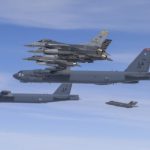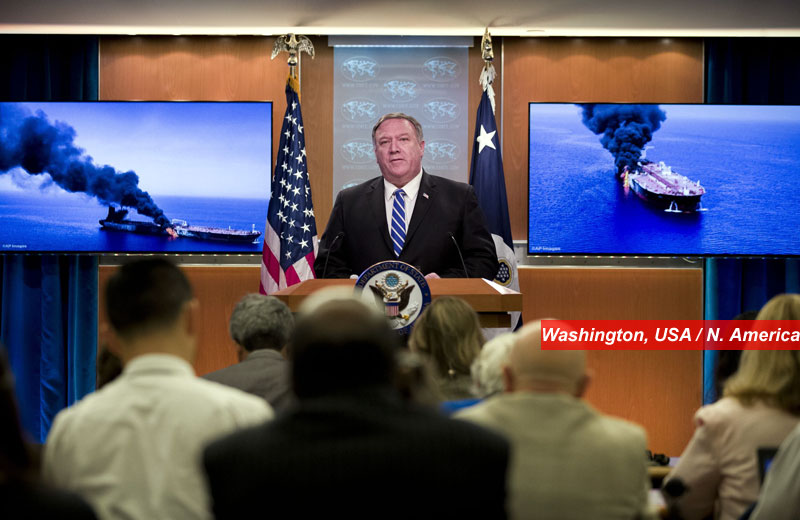
JUNE 14, 2019 1500 GMT | Washington, USA | US Secretary of State Mike Pompeo speaks at the State Department, Thursday, June 13, 2019, in Washington. Pompeo says Iran is believed to be responsible for attacks on 2 tankers near Persian Gulf. (AP Photo)
DUBAI, United Arab Emirates (AP) — The U.S. military on Friday released a video it said showed Iran’s Revolutionary Guard removing an unexploded limpet mine from one of the oil tankers targeted near the Strait of Hormuz, suggesting the Islamic Republic sought to remove evidence of its involvement from the scene.
The U.S. Navy rushed to assist the stricken vessels in the Gulf of Oman off the coast of Iran, including one that was set ablaze Thursday by an explosion. The ships’ operators offered no immediate explanation on who or what caused the damage against the Norwegian-owned MT Front Altair and the Japanese-owned Kokuka Courageous. Each was loaded with petroleum products, and the Front Altair burned for hours, sending up a column of thick, black smoke.
Iran has denied being involved in the attack, calling it an “unfounded claim” in the U.S.′ “Iranophobic campaign.” However, Iran previously used mines against oil tankers in 1987 and 1988 in the “Tanker War,” when the U.S. Navy escorted ships through the region.
The black-and-white footage, as well as still photographs released by the U.S. military’s Central Command, appeared to show the limpet mine on the Kokuka Courageous.
A Revolutionary Guard patrol boat pulled alongside the ship and removed the mine, Central Command spokesman Capt. Bill Urban said.
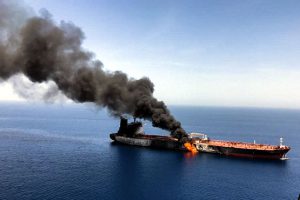
Secretary of State Mike Pompeo says the U.S. believes Iran is responsible for attacks that damaged two oil tankers near the Persian Gulf Thursday. Pompeo said the attacks are part of a “campaign” of “escalating tension” by Iran. (June 13)
“The U.S. and the international community stand ready to defend our interests, including the freedom of navigation,” Urban said. “The United States has no interest in engaging in a new conflict in the Middle East. However, we will defend our interests.”
Iran earlier denied involvement via a statement from its mission to the United Nations.
“The U.S. economic war and terrorism against the Iranian people as well as its massive military presence in the region have been and continue to be the main sources of insecurity and instability in the wider Persian Gulf region and the most significant threat to its peace and security,” the statement said.
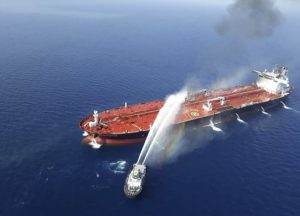
The suspected attacks occurred at dawn Thursday about 40 kilometers (25 miles) off the southern coast of Iran. The Front Altair, loaded with the flammable hydrocarbon mixture naphtha from the United Arab Emirates, radioed for help as it caught fire. A short time later, the Kokuka Courageous, loaded with methanol from Saudi Arabia and Qatar, also called for help.
The U.S. Navy sent a destroyer, the USS Bainbridge, to assist, said Cmdr. Joshua Frey, a 5th Fleet spokesman. He described the ships as being hit in a “reported attack,” without elaborating.
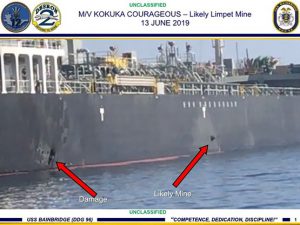
Thursday’s attack resembled that of an attack in May targeting four oil tankers off the nearby Emirati port of Fujairah. U.S. officials similarly accused Iran of targeting the ships with limpet mines, which are magnetic and attach to the hulls of a ship. The mines disable, but don’t sink, a vessel.
____
Newsroom | theworldmail.co.uk
Source/Contribution/Photo Credit UN | USCENTCOM | Associated Press



